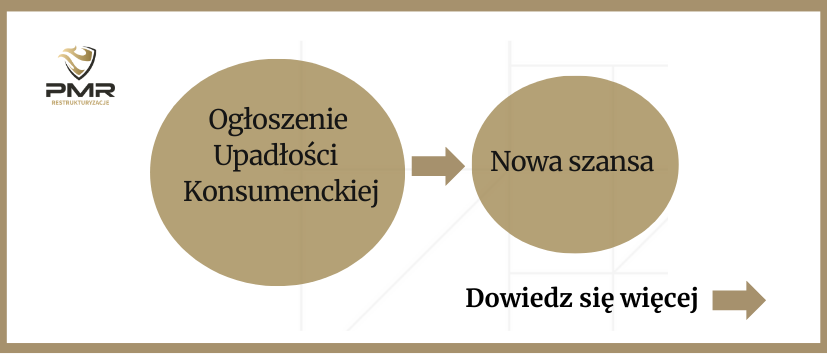Consumer bankruptcy is a court proceeding intended for individuals who do not conduct business activity and have become insolvent. Consumer bankruptcy allows individuals to discharge their debts and have a new chance to build their personal, family and professional life.
- A few words about the article - Listen
- What is consumer bankruptcy?
- What are the benefits of consumer bankruptcy?
- Who can declare personal bankruptcy?
- Who cannot file for personal bankruptcy?
- How to open consumer bankruptcy?
- How to write a petition for consumer bankruptcy?
- Opening of bankruptcy proceedings – what next?
- Summary
A few words about the article - Listen
What is consumer bankruptcy?

Consumer bankruptcy is a court proceeding intended for individuals who do not conduct business (private individuals) who have become insolvent. As a result of conducting consumer proceedings, such individuals can count on debt relief.
Declaring consumer bankruptcy does not mean that the debts of the bankrupt debtor will be written off "immediately". Before the debt is written off, the trustee, who is appointed by the Court after the opening of bankruptcy proceedings, is obliged to conduct liquidation proceedings, the purpose of which is to monetize the assets from which the liabilities of the bankrupt debtor are repaid. After the liquidation of the bankruptcy estate is completed, the trustee files a motion with the court to terminate the bankruptcy proceedings. without setting up a repayment plan or prepares a draft repayment plan, i.e. a document which specifies the amount and period for which the bankrupt will have to make repayments to creditors after the bankruptcy proceedings are closed.
What are the benefits of consumer bankruptcy?
Consumer bankruptcy allows an individual to get rid of their debts, which allows them to rebuild their private and professional life without the burden of debt.
The receivables that may be written off include primarily:
- Credits and loans – both banking and other financial institutions;
- Liabilities under civil law contracts – e.g. overdue payments for unpaid invoices or apartment rent;
- Overdue bills – e.g. for electricity, electricity, telephone, Internet;
- Liabilities arising from unpaid receivables resulting from past business activities;
- Obligations arising from guarantees;
- Tax arrears.
Based on the current financial situation of the Bankrupt, the Court will determine the repayment plan, i.e. in what periods and in what amounts the Bankrupt should repay his liabilities.
Of course, if the situation of a given person clearly indicates that he or she will not be able to repay even a part of his or her liabilities, the Court should terminate the bankruptcy proceedings without establishing a repayment plan, i.e. completely discharge the debt of such a person and write off his or her liabilities.
It should be noted that a great advantage of consumer bankruptcy is the discontinuation, after the opening of bankruptcy proceedings, of all enforcement proceedings initiated, including bailiff or debt collection proceedings, which people in a difficult financial situation are struggling with.
Who can declare personal bankruptcy?
A debtor who is a natural person, i.e. a consumer who is not an entrepreneur and does not conduct business activity, may file a motion to open consumer bankruptcy. An additional condition that the consumer must meet is their insolvency.
Insolvency is a state in which the debtor is unable to meet his or her due monetary obligations, e.g. he or she does not have money to simultaneously purchase everyday necessities and repay debts.
According to the provisions of bankruptcy law, it is presumed that the debtor has lost the ability to meet his due pecuniary obligations if the delay in repayment of debts exceeds three months.
With the above in mind, people who are in a difficult financial situation and who are in arrears with their current bills, as well as people who have fallen into a debt spiral (they cover the loan installments by taking out another loan) should consider whether consumer bankruptcy is not a solution for them.
Who cannot file for personal bankruptcy?
As indicated above, consumer bankruptcy is intended exclusively for private individuals who do not conduct business activity and are insolvent. Therefore, the court will reject a consumer application filed by individuals who:
- They run a business
- Over the last 10 years, bankruptcy proceedings have been conducted against such persons, who have been fully or partially discharged of their debts.
- They are not insolvent
- They provided false information in the application
How to open consumer bankruptcy?

The court can declare consumer bankruptcy only upon application. Therefore, a bankruptcy application is always the first step towards declaring bankruptcy.
If the application has been filed correctly and without formal defects, the court will declare consumer bankruptcy. The further procedure is as follows:
- When declaring bankruptcy of a consumer, the court issues a decision appointing a trustee;
- Once the bankruptcy notice is issued, the period begins during which creditors can file their claims;
- The trustee determines the existence of the bankruptcy estate, i.e. whether the bankrupt has any property that has become the bankruptcy estate as of the date of opening of bankruptcy proceedings;
- The trustee liquidates the assets included in the bankruptcy estate;
- The trustee prepares and files with the court an application to terminate the bankruptcy proceedings without establishing a repayment plan or submits a draft repayment plan;
- The court refrains from establishing a repayment plan or establishes a repayment plan for part of the liabilities;
- If a repayment plan is established, the bankrupt has the right to appeal against the court’s decision;
- If the repayment plan becomes final, the debtor executes the repayment plan and annually submits to the court a report on the implementation of the repayment plan.
- After the repayment plan is completed, the remaining unmet liabilities are written off.
How to write a petition for consumer bankruptcy?
The application for the declaration of consumer bankruptcy is a procedural document that initiates the bankruptcy procedure described above. This application is the first and extremely important document that is subject to the court's assessment and on the basis of which the trustee can learn more about the Bankrupt's situation.
Therefore, it is extremely important to prepare a complete bankruptcy petition, as it can significantly speed up its consideration by the Court and make it easier for the trustee to determine the actual situation of the Bankrupt, which directly translates into the speed of the bankruptcy procedure itself.
To prepare a complete consumer application, you need to prepare. You need to identify all creditors and receivables existing on the date of application. You need to confirm the amount of your receivables and their due dates. You should also collect documents confirming the existence and status of liabilities, such as credit agreements, payment demands or bailiff documentation. It is also worth documenting the current situation of the debtor himself, i.e. his marital status, health or professional situation.
In addition, the following information must be attached to the consumer application:
- List of assets with estimated valuation;
- Indication of the place where the debtor's assets are located;
- List of creditors with their addresses, amount of the obligation and due dates of the obligations;
- List of security interests established over the property;
- List of court, enforcement and administrative proceedings pending against the debtor.
As a rule, a consumer application should be submitted electronically via the Court Register Portal, and more precisely by the National Register of Debtors. The consumer application is subject to a fixed fee of PLN 30.
Opening of bankruptcy proceedings – what next?

Filing a consumer application should be preceded by a thorough analysis of the debtor's situation and the consequences of declaring bankruptcy. We indicate the most important ones below:
- After the declaration of bankruptcy, all of the debtor's assets become the so-called bankruptcy estate, which is managed by the trustee and the debtor cannot freely dispose of it.
- The bankruptcy estate will also include the debtor's remuneration in that part that does not constitute an amount exempt from seizure.
- After the declaration of bankruptcy, the debtor's assets will be liquidated. This means that the trustee, in order to satisfy the creditors to the greatest extent possible, will try to sell the bankrupt's assets.
- Once bankruptcy is declared, the debtor will no longer be able to enter into any obligations or enter into any other contracts that go beyond minor everyday contracts.
It is worth noting that all liabilities incurred after the declaration of bankruptcy, such as rent, utilities, telephone bills, should be settled on an ongoing basis.
Summary
Declaring consumer bankruptcy is a complete solution for people who have serious financial problems and want to get rid of them once and for all. However, debt relief itself does not happen "automatically". Bankruptcy means accepting that the trustee will sell the assets collected over the years, so as mentioned above, you should seriously consider whether consumer bankruptcy will be a good solution in this case.
Consumer bankruptcy has many advantages beyond debt relief. The suspension of debt collection and bailiff actions may be very attractive to many people, as such actions can have a strong psychological impact on the debtor.
Before deciding to file for bankruptcy, it is a good idea to consult with specialists in bankruptcy law, who will advise on what actions should be taken before and during bankruptcy proceedings and whether the existing liabilities justify the choice of bankruptcy proceedings as a method of debt relief.


























